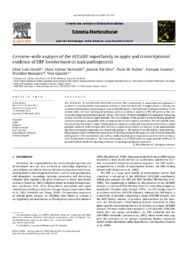Genome-wide analysis of the AP2/ERF superfamily in apple and transcriptional evidence of ERF involvement in scab pathogenesis.
Genome-wide analysis of the AP2/ERF superfamily in apple and transcriptional evidence of ERF involvement in scab pathogenesis.
Author(s): GIRARDI, C. L.; ROMBALDI, C. V.; DAL CERO, J.; NOBILE, P. M.; LAURENS, F. L.; BOUZAYEN, M.; QUECINI, V.
Summary: The APETALA2 (AP2)/ETHYLENE RESPONSE FACTOR (ERF) superfamily of transcriptional regulators is involved in several growth, development and stress responses processes in higher plants. Currently, the available information on the biological roles of AP2/ERF genes is derived from Arabidopsis thaliana. In the present work, we have investigated genomic and transcriptional aspects of AP2/ERF genes in the economically important perennial species, Malus ×domestica. We have identified 259 sequences containing at least one ERF domain in apple genome. The vast majority of the putative proteins display predicted nuclear localization, compatible with a biological role in transcription regulation. The AP2 and ERF families are greatly expanded in apple. Whole-genome analyses in other plant species have identified a single genomic sequence with divergent ERF, whereas in apple seven soloists are present. In the apple genome, the most noteworthy expansion occurred in sub-groups V, VIII and IX of the ERF family. Expression profiling analyses have revealed the association of ripening-involved ERF genes to scab (Venturia inequalis) pathogenesis in the susceptible Gala cultivar, indicating that gene expansion processes were accompanied by functional divergence. The presented analyses of AP2/ERF genes in apple provide evidences of shared ethylene-mediated signaling pathways in ripening and disease responses.
Publication year: 2013
Types of publication: Journal article
Unit: Embrapa Grape & Wine
Keywords: Condição fisiológica, Doença de planta, Etileno, Fruticultura, Fungo, Genoma, Genética, Maturação, Maçã, Pós-colheita, Venturia inequalis
Observation
Some of Embrapa's publications are published as ePub files. To read them, use or download one of the following free software options to your computer or mobile device. Android: Google Play Books; IOS: iBooks; Windows and Linux: Calibre.
Access other publications
Access the Agricultural Research Database (BDPA) to consult Embrapa's full library collection and records.
Visit Embrapa Bookstore to purchase books and other publications sold by Embrapa.

